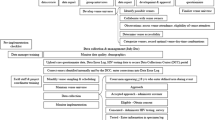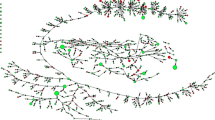Abstract
We examined differences in sample demographics across cycles of the National HIV Behavioral Surveillance project, that examines HIV risk behaviors among men who have sex with men (MSM), injection drug users (IDU), and heterosexuals living in areas of high HIV prevalence (HET). MSM were recruited through venue-based sampling, and IDU and HET through respondent driven sampling (RDS). RDS data were weighted to account for sampling bias. We compared crude prevalence estimates from MSM1 (2004) to those from MSM2 (2008) for demographic factors known to influence risky sexual and drug-use behaviors. We compared crude and adjusted prevalence estimates for IDU1 (2005) and IDU2 (2009) and HET1 (2006) and HET2 (2010). In the MSM cycle, we found differences in age, and the proportions seeking medical care and reporting a recent arrest. There were no differences in the comparison of crude and weighted estimates for the RDS collected samples, nor were there differences comparing HET1 and HET2 weighted estimates. IDU2 recruited a larger proportion of males, and had a higher percent who graduated from high school and who reported recent medical care and a previous HIV test. Differences across MSM cycles may be related to differences in venues identified for each cycle. Differences in the IDU cycles may be due to an effort on our part to increase the racial/ethnic and drug-use diversity of the sample in IDU2. Our findings show the importance of formative work for both venue-based and RDS samples to increase understanding of the dimensions that affect social networks and the dynamics of populations in space and time. With familiarity of the target population, we believe that both venue-based and RDS recruitment approaches for NHBS work well and can be used to evaluate changes in risky sexual and drug use behaviors and in HIV testing behaviors.
Resumen
Investigamos las diferencias en las características demográficas de las muestras a través de los ciclos del proyecto de Vigilancia Nacional del Comportamiento Relacionado con el VIH (National HIV Behavioral Surveillance, NHBS), examinando las conductas de riesgo del VIH entre hombres que tienen relaciones sexuales con hombres (HSH), los usuarios de drogas inyectables (UDI) y las personas heterosexuales que viven en áreas de alta prevalencia del VIH (HET). Los HSH fueron reclutados a través del muestreo en el lugar de reunión (venue-based sampling), y los UDI y HET a través del muestreo dirigido por los participantes (respondent driven sampling, RDS). Se analizaron los datos del RDS para tomar en cuenta el sesgo de la muestra. Comparamos los cálculos de la prevalencia en bruto del primer ciclo en HSH (2004) con aquellos del segundo ciclo (2008) en busca de factores demográficos que se sabe que influyen las conductas sexuales de riesgo y el uso de drogas. Comparamos los cálculos de la prevalencia en bruto y ajustada del primer (2005) y del segundo ciclo en UDI (2009), y del primer (2006) y del segundo ciclo en HET (2010). En los ciclos de HSH, encontramos diferencias de edad y en las proporciones de aquellos quienes buscaron atención médica y quienes reportaron un arresto reciente. No hubo diferencias en los cálculos brutos y ajustados en ninguno de los ciclos del RDS. Tampoco hubo diferencias al comparar los cálculos de la prevalencia ajustada a través de dos ciclos de HET. Sin embargo, el segundo ciclo en UDI reclutó a una mayor proporción de hombres y tuvo un mayor porcentaje de graduados de secundaria y de quienes reportaron atención médica reciente y una prueba del VIH previa. Las diferencias a través de los ciclos de HSH pueden relacionarse con las diferencias en los lugares identificados en cada ciclo. Las diferencias en los ciclos de UDI pueden deberse a un esfuerzo de nuestra parte para aumentar la diversidad racial/étnica y de los tipos usuarios de drogas en el segundo ciclo en UDI. Nuestros hallazgos demuestran la importancia de la investigación formativa tanto en las muestras en el lugar de reunión como de RDS para ganar un mejor entendimiento de los aspectos que afectan las redes sociales y las dinámicas de las poblaciones en el espacio y el tiempo. Con un buen conocimiento de la población objetivo, creemos que tanto las muestras en el lugar de reunión como el RDS son eficaces para el reclutamiento para las encuestas NHBS y se pueden utilizar para evaluar los cambios en las conductas sexuales de riesgo, el uso de drogas y los comportamientos con respecto al uso de las pruebas del VIH.


Similar content being viewed by others
References
Lansky A, Sullivan PS, Gallagher KM, Fleming PL. HIV behavioral surveillance in the U.S.: a conceptual framework. Public Health Rep. 2007;122:16–23.
Gallagher KM, Sullivan PS, Lansky A, Onorato IM. Behavioral surveillance among people at risk for HIV infection in the U.S.: the National HIV Behavioral Surveillance System. Public Health Rep. 2007;122:32–8.
MacKellar DA, Gallagher KM, Finlayson T, Sanchez T, Lansky A, Sullivan PS. Surveillance of HIV risk and prevention behaviors of men who have sex with men: a national application of venue-based, time-space sampling. Public Health Rep. 2007;122:39–47.
Semaan S. Time-space sampling and respondent driven sampling with hard-to-reach populations. Methodol Innov Online. 2010;5:60–75.
Heckathorn DD. Respondent driven sampling: a new approach to the study of hidden populations. Soc Probl. 1997;44:174–99.
Heckathorn DD. Extensions of respondent-driven sampling: analyzing continuous variables and controlling for differential recruitment. Sociol Methodol. 2007;37(1):151–207.
Magnani R, Sabin K, Saidel T, Heckathorn DD. Review of sampling hard-to-reach and hidden populations for HIV surveillance. AIDS. 2005;19:S67–72.
Stueve A, O’Donnell L, Duran R. Time-space sampling in minority communities: results with young Latino men who have sex with men. Am J Public Health. 2001;91:922–6.
Raymond HF, Ick T, Grasso M, Vaudrey J, McFarland W. Resource guide: time location sampling (TLS). San Francisco Department of Public Health, HIV Epidemiology Section, Behavioral Surveillance Unit. 2007. http://globalhealthsciences.ucsf.edu/sites/default/files/content/pphg/surveillance/modules/global-trainings/tls-res-guide-2nd-edition.pdf. Accessed 15 Sep 2012.
Karon JM. The analysis of time-location sampling study data. ASA Section on Survey Research Methods. Paper presented at the American statistical association. 2005. http://www.amstat.org/sections/srms/proceedings/y2005/Files/JSM2005-000306.pdf. Accessed 26 July 2013.
MacKellar DA, Valleroy L, Karon JM, Lemp G, Janssen R. The Young Men’s Survey: methods for estimating HIV seroprevalence and risk factors among young men who have sex with men. Public Health Rep. 1996;111:138–44.
Salganik MJ, Heckathorn DD. Sampling and estimation in hidden populations using respondent-driven sampling. Sociol Methodol. 2004;34:193–239.
Johnston LG, Whitehead S, Simic-Lawson M, Kendall C. Formative research to optimize respondent-driven sampling surveys among hard-to-reach populations in HIV behavioral and biological surveillance: lessons learned from four case studies. AIDS Care. 2010;22(6):784–92.
Abdul-Quader AS, Heckathorn DD, Sabin K, Saidel T. Implementation and analysis of respondent driven sampling: lessons learned from the field. J Urb Health. 2006;83:i1–5.
Volz E, Wejnert C, Degani I, Heckathorn DD. Respondent-driven sampling analysis tool (RDSAT). Version 5.6. Ithaca:. Cornell University. 2007. http://www.respondentdrivensampling.org/reports/RDSAT60.htm. Accessed 26 July 2013.
Goel S, Salganik MJ. Respondent-driven sampling as Markov chain Monet Carlo. Stat Med. 2009;28:2202–22229.
Updated Guidelines for Evaluating Public Health Surveillance Systems. Recommendations from the guidelines working group. 2001. MMWR. 50(RR13):1–35. http://www.cdc.gov/mmwr/preview/mmwrhtml/rr5013a1.htm. Accessed 26 July 2013.
Fenton KA. Changing epidemiology of HIV/AIDS in the United States: implications for enhancing and promoting HIV testing strategies. Clin Infect Dis. 2007;45:S213–20.
Oraquick and Orasure. http://www.orasure.com/products. Accessed 8 Jan 2008.
Bureau. USC. Income, poverty, and health insurance coverage in the United States. 2011. http://www.census.gov/hhes/www/hlthins/. Accessed 4 Oct 2014.
Sterne JAC, Bradburn MD, Egger M. Meta-analysis in stata. In: Egger M, Smith GD, Altman DG, editors. Systematic reviews in health care: meta analysis in context, 2nd ed. London: BMJ Publishing Group; 2001.
Harris RJ, Bradburn MJ, Deeks JJ, Harbord RM, Altman DG, Sterne JAC. Metan: fixed- and random-effects meta-analysis. Stata J. 2008;8(1):3–28.
Sanchez T, Finlayson T, Drake A. Human immunodeficiency virus (HIV) risk, prevention, and testing behaviors - United States, National HIV Behavioral Surveillance System: men who have sex with men, November 2003–April 2005. MMWR Surveill Summ. 2006;55:1–16.
Smith A, Miles I, Le B, Finlayson T, Oster A, DiNenno E. Prevalence and awarenss of HIV infection among men who have sex with men –21 cities, United States, 2008. MMWR. 2010;59:1201–7.
Centers for Disease Control and Prevention. HIV testing among men who have sex with men – 21 Cities, United States, 2009. MMWR. 2011;60(21):694–9.
Salganik MJ. Variance estimation, design effects, and sample size calculations for respondent-driven sampling. J Urb Health. 2006;83(Suppl 1):i98–112.
White RG, Lansky A, Goel S, Wilson D, Hladik W, Hakim A, et al. Respondent driven sampling - where are we and where should we be going? Sex Transm Infect. 2012;88(6):397–9.
Heckathorn DD. Respondent-driven sampling II: deriving valid population estimates from chain-referral samples of hidden populations. Soc Probl. 2002;49(1):11–34.
Acknowledgments
The authors wish to acknowledge the staff of the HIV Behavioral Surveillance Program in the Houston Department of Health and Human Services. This work was supported by cooperative agreements from the Centers for Disease Control and does not necessarily represent the official views of the Centers for Disease Control and Prevention. Its contents are solely the responsibility of the authors.
Author information
Authors and Affiliations
Corresponding author
Rights and permissions
About this article
Cite this article
Risser, J.M.H., Montealegre, J.R. Comparison of Surveillance Sample Demographics Over Two Cycles of the National HIV Behavioral Surveillance Project, Houston, Texas. AIDS Behav 18 (Suppl 3), 382–390 (2014). https://doi.org/10.1007/s10461-013-0562-5
Published:
Issue Date:
DOI: https://doi.org/10.1007/s10461-013-0562-5




